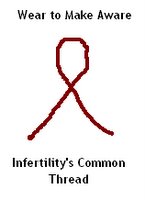by TeamWinks and Serenity
What a Uterine Anomaly Means and Its Impact on Fertility
A uterine anomaly is a form of congenital birth defect - in that the uterus forms when the fetus is inside her mother's womb.
About ten weeks after conception, the uterus is comprised of a pair of structures called mullerianducts. The top of the ducts (i.e. the ones closest to the embryo's head) will become the fallopian tubes - they remain separated throughout development.The bottom of the mullerian ducts, however, begin to fuse together to become one structure that will become the uterus. At stage one of this fusion, they have formed a central wall, or "median septum" in the middle of the fused tube. This structure, when first formed, is a cylindrical structure of equal diameter.
Between ten and thirteen weeks, the central wall of this tube begins to expand at the top to form the uterus fundus. At the bottom of the uterus, this central wall, or median septum also begins to dissolve; leaving a continuous chamber that will become the uterine cavity.Between weeks thirteen and twenty, the median septum should dissolve completely from the bottom to the top of the uterus, resulting in a single, continuous uterine cavity.
Uterine anomalies result from the following:
- failure of one of the two mullerian ducts to form (unicornuate),
- failure of the two ducts to fuse completely (bicornuate), or
- failure of the two fused mullerian ducts to dissolve the median septum (septate).
Diagnostic Process
Some uterine abnormalities can be diagnosed with a simple ultrasound - a bicornuate uterus, for example, sometimes clearly shows two uterine cavities (or "horns.") However, once a uterine abnormality is identified, it does take some work to fully diagnose it. The best method of diagnosis is generally a hysteroscopy and/or laparoscopy, but that requires the use of generalanesthesia and is generally more expensive.
A HSG & Saline Infusion Ultrasound, where they fill your uterine cavity with fluid/dye can give your RE a good idea of what type of abnormality exists. Your RE may want to perform a MRI, CT scan, and/or 3D ultrasound as well.
Treatment Options and Prognosis
Treatment of a uterine abnormality is entirely dependent on which type of diagnosis you receive and your RE. Generally, however, a septate uterus will present fertility issues in that the septum has no blood flow and will sometimes interfere with the implantation process. In that case, a hysteroscopy and laparoscopy will be recommended, where your RE will surgically remove the septum. Depending on its size, you may need multiple procedures. Unicornuate and bicornuate uterus diagnoses will often not be treated at all, since with both types there tends to be a normal blood flow to the uterus. However, there is an increased chance of preterm labor - since the uterus doesn't stretch like a "normal" uterus would. Thus, when a woman with this type of anomaly becomes pregnant, some doctors classify them as high risk.
Personal Experience
TeamWinks's perspective
Once you learn that you have a uterine anomaly, you can expect a whole lot of confusion. It is often very difficult to pin down exactly what your uterus looks like. Reproductive outcomes for women with these anomalies aren't all that reassuring, and it certainly doesn't help that there is a lack of literature out there to educate yourself. Be prepared to primarily read literature that was prepared for other doctors and not the average woman. They are often dense articles, and take time to work through. There is a wonderful support group on yahoo that does help (http://health.groups.yahoo.com/group/MullerianAnomalies/)
I am not sure whether I have a bicornuate uterus or a unicornuate uterus. My RE has been unable to pin this one down. Soon we should know for sure. I would say on a good day that having this birth defect can be difficult. Often women with a uterine anomaly have only one kidney. Thankfully I have two. They also have high incidences of PCOS, endometriosis, insulin resistance, high miscarriage rates, and pre-term labor. That's a strong cocktail thrown at you at once. I truly believe you need a support system from the moment the diagnosis is handed to you. It's important to remember that it isn't a death sentence. However, it is important to ask as many questions as you can.
Serenity's perspective
My RE thinks that I have a true bicornuate uterus, which was diagnosed last year after my hysteroscopy. But given our recent IVF failures and that we believe it might be implantation related, we are revisiting this at the end of the month, however, with a 3D ultrasound to ensure that he didn't miss a septum earlier. The biggest thing to remember: the statistics and risks they throw at you when you're diagnosed are often skewed. There are a lot of women who a have bicornuate/unicornuate uterus who have never been diagnosed; they have gone on to get pregnant and have perfectly normal pregnancies and healthy babies. My OB and my RE told me that having a bicornuate uterus was probably the "best" one to have, practically speaking, since I have good endometrial lining in both horns. They have also told me that the bulk of women who have this to go on and bear very healthy, normal children. So my advice would be to take the risks you'll read about with a grain of salt.
Links for uterine anomaly research:
http://www.rbaonline.com/uterine.asp
http://www.emedicine.com/med/topic3521.htm
In addition, Preventing Miscarriage by Jonathan Scher has some information about uterine anomalies and their role in miscarriage.



























6 comments:
This information was very helpful and hopeful to me as my daughter has recently been diagnosed with bicornuate uterine anomaly. Further testing is being done to decipher the extent of this situation. Thank you for your site. I have not heard of this congenital abnormality before.
I found out in college that I had a vaginal septum, and resulting two cervices, when I went to the Gynocologist for the first time. It was very unsettling. SInce then I have gotten used to being a lab specimin for residents and newly minted doctors. I got used to reminding the nurses on my annual visits that I would need two PAP smears.
I was told initially that it would be difficult to become pregnant, that I would be suseptible to miscarriange and may not be able to carry a baby to term.
After a long duration of not seeking to get pregnant (long story), my DH and I wanted to find out if it was possible. I had this anomoly and that I was pushing the age limit (just over 40). My RE decided it was time to find out exactly what was going on under the hood and I had a lap/hysteroscopy. They removed the vaginal septum during the procedure, but what they didn't expect to find was that I had a uterine septum too. The RE did not remove it at that time because he didn't have my permission to so so. He intimated that if I were 24, he'd recommend that I have surgery in the future to remove it. But since my time is limited, he recommended to try my luck with it.
This is the second poster again, the one who found out recently about a uterine septum during a lap/hysteroscopy.
As a follow-up, I just wanted to let those who may have this condition that chances tog et pregnant aren't completely dire. In December 2008, I took my first round of clomid and found out on New Years Eve 2008 that I was pregnant. I am due in September 2009.
Please don't give up ladies, I to was diagnosed with a bicornuate uterus back in 1985, after surgery,3 months later I was allowed to start back with my clomid, (150mg)I got pregnant and carried 38 weeks and had a scheduled c-section giving birth to a healthy 6 lb 9 oz baby boy, followed 20 months later with another 38 weeker, a 7 lb 2 oz baby girl, the trick is finding a good Dr who knows what they are doing, it is not a hopeless diagnosis, please keep the faith :-)
I was diagnosed with uterus didelphys and septum (two uterus and two cervix) over a year ago. I am 31 years old next month. Doctors told me that I should be able to conceive and carry baby, but at high risk for preterm labor. I hope to marry in the near future and give it a go! I am documenting my journey on my new blog. I am both excited and nervous about my reproductive future!
I am 54yo .. about to turn 55 and have a bicornate uteri fully divided and both fully functional. well were until I hit menopause.
my DD was carried in the right urerus.. and my DS in the left (funny note: she is right handed he is left handed..LOL) both were 4 weeks early.. beautiful and healthy..
I am now awaiting hysterectomy because I have a thickened endometrial lining (13mm) and because of my anatomy.. {{grin}} they can not biopsy it. apparently little swimmers can go up.. but nothing else.. and blood can come down but nothing else.
So I am told, it was a good thing I had both babies C-sections.
to all who have such.. it can be fun.. and funny.. but do take good care post menopause. it can be a problem too.
Post a Comment